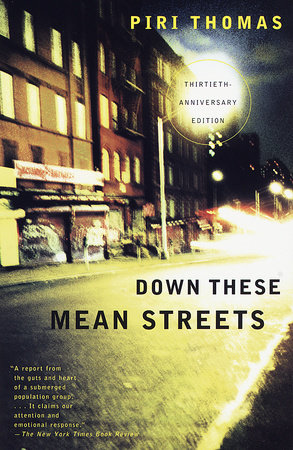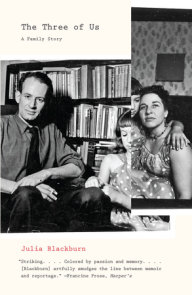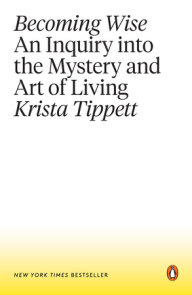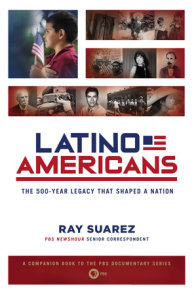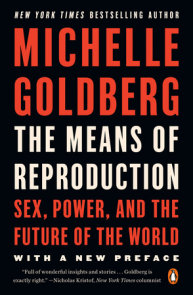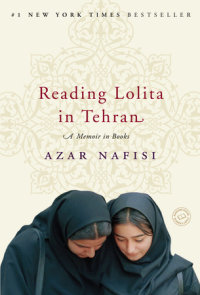TEACHING GUIDE
NOTE TO TEACHERS
Years after its original publication, Piri Thomas’s Down These Mean Streets remains as powerful, immediate, and shocking as it was when it first stunned readers. In this classic confessional autobiography, firmly in the tradition of Eldridge Cleaver’s Soul on Ice and The Autobiography of Malcolm X, Piri Thomas describes the experience of growing up in the barrio of Spanish Harlem, a labyrinth of lawlessness, drugs, gangs, and crime. The teenaged Piri seeks a place for himself in barrio society by becoming a gang leader, and as he grows up his life spirals into a self-destructive cycle of drug addiction and violence, the same cycle that he sees all around him and hardly knows how to break. Piri is also troubled by a very personal problem: much darker than his brothers and sisters, he decides that he, unlike his siblings, is black, and that he must come to terms with life as a black American. Eventually arrested for shooting two men in an armed robbery, Piri spends six years in Sing Sing and Comstock prisons. With insight and poetry he describes his time in prison, the dreams and emotions that prompted him finally to start life again as a writer, street poet, and performer, and how he became an activist with a passionate commitment to reaching and helping today’s youth.
One of the most striking features of Down These Mean Streets is its language. “It is a linguistic event,” said The New York Times Book Review. “Gutter language, Spanish imagery and personal poetics…mingle into a kind of individual statement that has very much its own sound.” Piri Thomas’s brilliant way with words, his ability to make language come alive on the page, should prove attractive to young people and inspire them to look at writing and literature in fresh new ways.
TEACHING IDEAS
Preparing to Read
The questions, assignments, and discussion topics that follow are designed to guide your students as they approach the many issues raised in Down These Mean Streets. The questions of race and culture, of drugs, and of crime and punishment are all treated in the book, and should provide jumping-off points for many fruitful discussions. Another important element of the book is its vivid description of the youth culture of the barrio. Ask your students not only to pay special attention to that culture, but also to compare it with their own, and to look for similarities even when similarities might not be immediately evident. Piri Thomas gained the distance and objectivity to observe his world without prejudice or self-deception; your students should try to do the same. Finally, the students should be encouraged to look at the book not only as a cultural document, but also as a work of literature. Ask them to examine the language Thomas uses, his choice of words, the “flow” of the story. How does he create his informal tone, his sense of immediacy? This work might help change your students’ ideas about the “right” way to write, and inspire them to try to find their own individual voices.
DISCUSSION AND WRITING
Understanding the Story
Part One: Harlem
1)Why does Poppa hit Piri with his belt? Do you think that Poppa’s way of relating to Piri is good or destructive? How does he show his affection for Piri?
2)What is a tapita [p. 5], and what are the junkies doing?
3)“A twelve-year-old kid walking the streets at 3 a.m. was a nothing sight in Harlem.” [p. 6] Why doesn’t the policeman stop Piri when he sees him alone in the streets? Would this happen in other cities or neighborhoods? Would it differ today?
4)What is the W.P.A.? What was its role during the Great Depression? What is Poppa’s attitude toward the W.P.A.?
5)Moms is homesick for Puerto Rico and feels that life was better there. Do you think she is being realistic, or merely nostalgic? How is community life in a village society different from community life in a big city?
6)What happened after the bombing of Pearl Harbor? [p. 13] How did life change for the Thomas family after that event?
7)“Getting yourself a chick was a rep builder.” [p. 15] What does Piri mean by this?
8)What does it mean to Piri and his friends to become “hombre”? [p. 15]
9)Who are Whiplash and Scarface? Why does Piri make them his role models? What have these characters to do with the kind of life Piri lives in Harlem?
10)“Carlito was gonna be a junkie, like most of us would be—but that was in the future.” [p. 17] Why do so many of these young people turn to drugs? Has this situation changed much in the fifty years since Piri was a teenager?
11)On page 18, Piri says how hard it was to hustle up twelve dollars: “Every damn bottle we could steal from one grocery store to sell to another…. And all the change we could beat out of our girl-debs.” Does Piri imply here that stealing and beating girls are natural and accepted activities among his friends?
12)Piri feels that Poppa doesn’t love him as much as the others. Do you think that Poppa really is harder on Piri because he is darker? Or perhaps because parents are often strictest with the oldest child? How does Piri’s perception of his father’s attitude affect his self-image and, eventually, his life?
13)Why are the Italians and Latinos in Piri’s new neighborhood so hostile to one another? Is it because of a real cultural clash, or is this kind of conflict just part of human nature?
14)Why does Rocky’s attitude to Piri change after Rocky and his gang attack Piri and hurt his eyes? How does Piri now feel about Rocky?
15)Listening to the woman next to him at the Home Relief Agency[p. 43], Piri observes that “Her pleading was too close to my people’s: taking with outstretched hands and resenting it in the same breath.” What does he mean by this, and why does he turn away from her? Why does he feel ashamed when his mother lists all the things they need to the investigator, but then add his own item to the list, gloves? [p. 45]
16)“I wonder if Poppa didn’t like Jews the way I didn’t like Italians.” [p. 46] Which characters in Down These Mean Streets stereotype others by race, and why?
17)What does it mean to have corazon, “heart”? How does the fight on page 50 illustrate the rules and principles by which the teenage gangs live?
18)How does Piri feel about the transvestites whose apartment he visits? [pp. 55–62] Do his attitudes change during the visit? Why does he accompany his friends there in the first place?
19)“School stunk…. Only chumps worked and studied,” Piri says early in the book. [p. 64] Yet as he grows older, he begins to take a real interest in his studying, and eventually becomes a writer. Why does he feel, as a teenager, that school is a place for chumps? Does this attitude reflect the attitude of those around him, or teenagers as a whole?
Part Two: Suburbia
1)What are paddies?
2)How does Piri feel initially about the white kids at his new school? Does he keep an open mind? What effect do Marcia’s words have upon the way he feels about Babylon? Do you think that he is right to turn against whites after hearing Marcia’s cruel statements?
3)While he is together with Betty, Piri says to himself, “Damn it, I hate you—no, not you, just your damn color.” [p. 90] Why do Piri’s experiences in Babylon make him hate white people as he never did in Harlem?
Part Three: Harlem
1)When Piri and Louie apply for sales jobs, they discover that white applicants are getting the jobs and black ones are being told to wait until they are contacted. Do you think that this sort of practice still occurs? Can society combat this kind of discrimination?
2)When, and why, does Piri begin to use drugs regularly? How much does peer pressure have to do with his decision to take cocaine?
3)How do you feel about the way Piri treats Trina at the party? [pp. 111–13] What is Trina’s response to this kind of treatment and why?
4)“What a world! Whether you’re right or wrong, as long as you’re strong, you’re right.” [p. 118] Is this a fair description of the world Piri lives in? Does it apply to other communities and societies? Does it still apply today?
5)What sort of relationship do Piri and Brew have when we first see them together? What does Brew tell Piri about race relations? Who turns out to be right, Piri or Brew?
6)Why does Piri want to go south?
Part Four: Suburbia
1)After his encounter with the white woman in the subway car, Piri imagines her talking to her friends about it. “It was with a colored boy…. In that one second, I was never so ashamed of myself.”
[p. 141] Why does he believe this? Do you think his imaginings might be accurate?
2)Why do Piri and José fight each other? [p. 146] Why does Piri refer to it as a “Cain and Abel scene”? [p. 147] Why does Piri say that José made a choice between a brother and a color? [p. 149]
3)Why does Poppa decide to be Puerto Rican rather than black? Is it necessary for him to make a choice? What impact could it have on their lives?
Part Five: Down South
1)How do Alayce’s thoughts about race differ from Brew’s? Piri thinks that Alayce sounds “just like José” [p. 159]—do you agree?
2)How does the South, as Brew and Piri describe it, differ from the North in treatment of African Americans?
3)“You’re prejudiced, too, Piri,” Brew says [p. 167], and goes on to imply that every person, and every culture, has its own prejudices. Do you agree with this point of view? What is Piri’s reaction to it?
4)How does Gerald West define himself racially, and why has he chosen this definition? What are the reactions of Brew and Piri to Gerald’s opinions? Does Piri, finally, come to have respect for Gerald? “I ask you,” Gerald says, “if a white man can be a Negro if he has some Negro blood in him, why can’t a Negro be a white man if he has white blood in him?” Can you answer his question?
5)Do you think that Piri’s method of dealing with the officer who called him “boy” is a good one?
6)What does Piri’s encounter with the white prostitute in Texas tell us about racial attitudes in Texas, and about Piri’s own state of mind?
7)On page 191, Isaac and Piri talk about the possibility of killing a white person. What does Piri conclude during this conversation? What is his real attitude toward killing?
Part Six: Harlem
1)Piri gets hooked on heroin, though he sees what it has done to his friends. Why? Do you think education is effective in combating drug use? What about “just say no” campaigns? If not, what would be effective?
2)After beating up the car salesman, Piri says, “Outside I was cara palo, but inside I heard Momma’s voice saying, ‘Mi negrito, mi negrito, what have you done?’” [p. 221] What does this tell us about Piri’s state of mind?
3)“It’s sure tough to be a broad,” Piri thinks after Dulcien has her baby, “but that’s life.” [p. 226] Does Piri’s attitude to Dulcien shock you, or do you think it is natural and sensible? What does he mean when he says, “I didn’t know what that meant—want, take, love, sex, belong, have—I just didn’t know”? [p. 226]
4)Does Piri’s decision to shoot the two men spring from racial hatred, or would it have happened even if they were not white? “I never thought paddies could waste other paddies like that,” he thinks [p. 237]: Do you find it odd that he puts even this situation in racial terms, rather than in terms of criminal and victim?
Part Seven: Prison
1)To what extent is Harlem’s communal code of pride, masculinity, and “rep” re-created in prison life? How does life inside prison resemble life outside?
2)“The reasoning that my punishment was deserved was absent. As prison blocks off your body, so it suffocates your mind.” [pp. 255–56] Does this indicate to you an essential fault in the prison system?
3)Do you think that the advice Piri gives Tico about how to deal with Rube is good?
4)Is prison a purely negative experience for Piri, or are there good things about it? Which of the people he meets while in prison enrich and improve his life?
5)Does Piri decide not to join the rioters, or is the decision essentially made for him by the hacks?
6)Why does Chaplin/Muhammed believe that Christianity is the white man’s religion, Islam the black man’s? Do outside or societal factors play a role in Chaplin/ Muhammed’s choice of religions?
7)As he leaves prison, Piri says, “I ain’t ever gonna be the same. I’m changed all right.” [p. 306] In what ways has Piri changed, and what has changed him? Which of his ideas have been altered by his time in prison?
Part Eight: New York Town
1)Why do you think Thomas chooses to end the book where he does, with his encounter with Carlito? What does he imply about his own future?
The characters of Down These Mean Streets
1)Piri: Piri presents himself as a product of his race, culture, and community, but many of his traits are purely his own. How would you describe Piri’s personality?
2)Poppa: What kind of a person is Poppa? What makes him proud, what makes him ashamed? Is he a good or bad father, a good or bad husband? Do you find him sympathetic?
3)Trina: Piri sees Trina as nearly perfect. How would you describe her? Do you think that she behaves passively toward Piri, or does she demonstrate spirit of her own? What do you think of her response to Dulcien’s baby?
4)Brew: How would you describe Brew’s character? What has given him his outlook on life, and how does it differ from Alayce’s? How does he perceive Piri? Why does he agree to go south with Piri?
5)Chaplin/Muhammed: What has made Muhammed hate Christianity? What does Islam mean to him?
In-depth discussion
1)How would you describe the youth culture in Spanish Harlem, of which Piri is a part? What do these young people consider important? How do they define themselves and measure themselves against others? Why do they fight? Is the fighting really about hatred or hostility, or does it mean something else? Why are the boys so territorial? Why is school, and learning, scorned by these young people?
2)“In Harlem stealing was like natural.” [p. 72] In Piri’s world, crime is a fact of life, and there is very little discussion of crime on a moral level. What is your reaction when Piri talks about holding up a store, or stealing ten dollars from the Puerto Rican girl who befriended him? Do you think that Piri feels guilty about shooting the men he has wounded? And if not, why?
3)How are women portrayed in Down These Mean Streets? How would you describe the way women are perceived and treated? How much independence, how much leeway for making personal decisions and choices does a young woman like Trina have? Does this reflect American culture or the time period in which the book is set, or both?
4)How does the relationship between Piri and Brew change during the course of the book, and what do those changes say about Piri’s perception of himself and his understanding of his own place in American society? When we first see Piri and Brew together, Piri asks himself, “Was I trying to tell Brew that I’m better than he is ’cause he’s only black and I’m a Puerto Rican dark-skin?” [p. 122] How does Piri feel about Brew by the end of the book, and how does the trip south contribute to changing his feelings? At what point in his life does Piri start to think of himself as black?
5)Piri describes his life in prison in some detail. Do you feel that the system he describes is designed to rehabilitate or to punish criminals? Is it effective? How many of them will continue in a life of crime?
6)Brew accuses Piri of being prejudiced. Do you find that to be true? Against what group or groups is Piri prejudiced? Which of his prejudices are cultural, and which has he acquired from his own experiences?
7)Piri has intermittent, but searching, thoughts about religion. As a teenager, religion means little to Piri; he “sat down to dinner and listened to Momma talk about Christian living without really hearing her.” [p. 27] In prison, he is impressed by the character of the chaplain, and listens to what he has to say. He also carefully considers the words of Chaplin/Muhammed on Islam. Why does Piri decide not to become a Muslim? What are his feelings about God by the end of the book?
8)Perhaps the most important relationship in this book is the relationship between Piri and his father. How did his father affect Piri’s life and help to make him, for better or worse, what he was?
BEYOND THE BOOK
1)Piri Thomas uses a number of pungent expressions, both in Spanish and English. How does the language he uses express his character and his world? Write a two-page essay describing one day in your life. Use your own style of talking, and try to be as colloquial as possible. What might your essay tell the reader about you, your friends, and your world?
2)The youth culture in Spanish Harlem to which Piri and his friends belong has certain firm, if unwritten, rules. Would you say the same is true of your own school or neighborhood? What are the rules that govern the behavior of young people you know? What do you feel you have to do to be “cool,” to be accepted, to belong? Write a short essay describing the social rules your own friends follow.
3)Piri is describing a specific period in time: the 1940s. Do you find that the life a family like the Thomases lived has changed much since that time? Make a list of the things that have changed for teenagers like Piri, and of the things that have stayed the same.
4)Down These Mean Streets is written very much from a male point of view. Try to look at the story from a different angle. Pretend that you are Trina, Moms, or Dulcien. Write a short essay from the point of view of one of these women. Tell what your life is like, how you feel about Piri and the other men in your life, what your responsibilities, wishes, and dreams might be.
5)Much of Down These Mean Streets deals with violent crime. Has violent crime had an impact on your own life? Do you believe that our current criminal justice system is the most effective way of dealing with it? Can you think of any good ways to improve the system?
6)During the period Piri Thomas describes, the South enforced strict segregation laws, called “Jim Crow” laws, that were not in effect in the North. Research the history of these laws. What was allowed for African Americans, and what was not allowed? How long did these laws remain in effect, and when and why did they end?
OTHER TITLES OF INTEREST
Harold Autenbaum and Ilan Stevens, eds., Growing Up Latino: Memoirs and Stories; James Baldwin, The Fire Next Time, Nobody Knows My Name; Claude Brown, Manchild in the Promised Land; Lorene Cary, Black Ice; Sandra Cisneros, The House on Mango Street; Eldridge Cleaver, Soul on Ice; Ralph Ellison, Invisible Man; Lorraine Hansberry, A Raisin in the Sun, To Be Young, Gifted and Black; Martin Luther King, Jr., Stride Toward Freedom, Why We Can’t Wait; Edward Rivera, Family Installments: Memories of Growing Up Hispanic; Luis J. Rodriguez, Always Running: La Vida Loca: Gang Days in L.A.; Esmeralda Santiago, When I Was Puerto Rican; Earl Shorris, Latinos: A Biography of the People; Cornel West, Race Matters; C. Vann Woodward, The Strange Career of Jim Crow; Richard Wright, Native Son; Malcolm X, The Autobiography of Malcolm X.
ABOUT THIS GUIDE
This teacher’s guide was written by Brooke Allen. Brooke Allen has a Ph.D. in literature from Columbia University, and has spent several years in France as a teacher and a journalist. She writes regularly on books for The New Criterion, The Wall Street Journal, and other publications.
×
Become a Member
Just for joining you’ll get personalized recommendations on your dashboard daily and features only for members.
Find Out More Join Now Sign In






